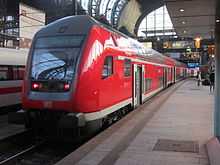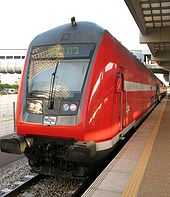Bombardier Double-deck Coach



The Bombardier Double-deck Coach is a bilevel passenger car built by Bombardier Transportation (formerly by Adtranz) used by various European railways. The current generation of double-deck coaches can be run at speeds up to 160 km/h (99.4 mph). Depending on their configuration, each coach can seat 100 to 150 passengers.
History
The ancestry of these coaches can be traced back to double-deck coaches built by WUMAG at Görlitz for the Lübeck–Büchen–Hamburg railway in 1935. They were push-pull trains with a cab car that could control the steam locomotive at the other end of the train.
After World War II, these coaches were developed further by VEB Waggonbau Görlitz (formerly WUMAG) into double-deck trains of two to five cars sharing bogies. Starting in 1974, single coaches were built again that were the direct ancestors of today's double-deck coaches. These trainsets were used by Deutsche Reichsbahn of the GDR as well as several other railways of the eastern bloc in large numbers (about 4000). After 1990, VEB Waggonbau Görlitz became part of Deutsche Waggonbau AG (DWA) which was acquired by Bombardier Transportation in 1998.
First Generation
Build years 1973–1974 and 1976–1991, sold to East Germany, Bulgaria, Poland, Romania, Czechoslovakia.
![]() Media related to Driving double-decker carriages of Germany 1st headshape at Wikimedia Commons
Media related to Driving double-decker carriages of Germany 1st headshape at Wikimedia Commons

| DB class | Vmax | count | UIC type | notes |
|---|---|---|---|---|
| 777 | 120 | DABbuzf | cab car | |
| 778 | 140 | DABbuzf | cab car |
Second Generation
Build years 1992-1993 for Germany (Deutsche Reichsbahn and Deutsche Bundesbahn, later named DB Class 760.
![]() Media related to Driving double-decker carriages of Germany 2nd_headshape at Wikimedia Commons
Media related to Driving double-decker carriages of Germany 2nd_headshape at Wikimedia Commons

| DB class | Vmax | count | UIC type | notes |
|---|---|---|---|---|
| 760 | 140 | 100 | DABbuzf | cab car |
Third Generation
Built between 1994 to 1997 under the DWA brand for Germany's (Deutsche Bahn).
![]() Media related to Driving double-decker carriages of Germany 3rd_headshape at Wikimedia Commons
Media related to Driving double-decker carriages of Germany 3rd_headshape at Wikimedia Commons

| DB class | Vmax | count | UIC type | notes |
|---|---|---|---|---|
| 761 | 140 | 58 | DABbzf | cab car |
| 762 | 140 | 31 | DABpbzf | cab car |
Fourth Generation
Built since 1997 and sold under the Bombardier brand to railways in Germany, Denmark, Israel and others.
![]() Media related to Driving double-decker carriages of Deutsche Bahn 4th headshape at Wikimedia Commons
Media related to Driving double-decker carriages of Deutsche Bahn 4th headshape at Wikimedia Commons

| DB class | Vmax | count | UIC type | notes |
|---|---|---|---|---|
| 763 | 160 | 50 | DABpbzf | cab car (originally 140 km/h) |
| 764 | 140 | 39 | DABpbzf | cab car |
| 765 | 160 | 55 | DABpbzfa | cab car (originally 160 km/h) |
| 766 | 160 | 55 | DABpbzfa | cab car |
| 767 | 160 | DABpbzfa | cab car |
Fifth Generation

In 2008 Bombardier presented the "Dosto 2010" future family of double-deck trains for the German market. For international sales they were branded as Bombardier TWINDEXX with a "Vario" concept that allows these trains to be built for regional or intercity connections up to 160 km/h. The high-speed rail versions are named Bombardier TWINDEXX Express allowing up to 230 km/h. A tilting variant of the Twindexx is developed for the Swiss railway named Bombardier TWINDEXX Swiss Express. Orders have been placed in the range of a few hundred coaches of the different variants with their initial delivery expected to be during 2015.